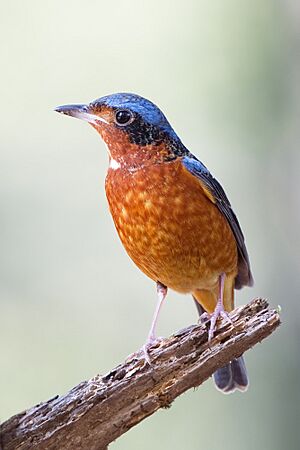White-throated rock thrush facts for kids
Quick facts for kids White-throated rock thrush |
|
|---|---|
 |
|
| Male, non-breeding | |
 |
|
| Female | |
| Conservation status | |
| Scientific classification | |
| Genus: |
Monticola
|
| Species: |
gularis
|
The white-throated rock thrush (Monticola gularis) is a type of bird. It belongs to the Muscicapidae family, which includes many small songbirds. This bird lives in temperate forests.
Contents
About the White-Throated Rock Thrush
This bird is quite small. It usually weighs about 34 grams, which is like a few pieces of candy. Its length is about 16 to 19 centimeters. That's roughly the length of a standard pencil! These birds typically live for about 3.8 years.
What They Look Like
Male white-throated rock thrushes are easy to spot. They have white patches on their chin and throat. The rest of their belly is a pretty chestnut-orange color. They also have parts that are cobalt blue and black.
Female birds look a bit different. Their upper feathers are brown or olive-brown. Their lower parts have a cool "scalloped" pattern. Young male birds have gray or golden-brown feathers. They also have orange undersides.
Their Special Song
The white-throated rock thrush has a unique song. People describe it as "melancholy." It sounds like a flute and has long, rising whistles.
Where They Live and Travel
The white-throated rock thrush lives in a huge area. This area covers about 1.7 million square kilometers!
Their Home and Travels
These birds are originally from places like Manchuria and the Russian Far East. They spend their summers there and raise their young. When winter comes, they fly south. They travel to warmer places like Indochina and southern China. Sometimes, you can even see them in Japan, Hong Kong, and Singapore.
The number of these birds is not known exactly. But their population is not getting smaller or bigger. This is good news for the species.
Their Habitat
White-throated rock thrushes love living in different kinds of places. They can be found in:
- Forests
- Shrubland (areas with lots of bushes)
- Rocky areas
They live at different heights, from sea level up to about 1500 meters (about 4,900 feet) high.
Conservation Status
The white-throated rock thrush is listed as "least concern" by the IUCN Red List. This means they are not currently in danger of disappearing.
Life Cycle and Diet
White-throated rock thrushes are busy during the warmer months.
Breeding and Nests
They arrive at their breeding grounds between May and September. These grounds are usually in mixed montane forests (forests on mountains). They breed from May to July. During this time, they can raise two groups of babies.
Their nests are shaped like a cup. They build them using different natural materials. The inside of the nest is soft, made of tree matter, lichen, small roots, and moss. The outside is stronger, built with pine needles and stems.
What They Eat
The diet of these birds is mostly invertebrates. These are small creatures without backbones. Some of their favorite foods include:
- Weevils (a type of beetle)
- Mole crickets
- Lepidopterans (like butterflies and moths, often in their caterpillar stage)
Migration
The white-throated rock thrush is a fully migrant species. This means they travel long distances between their summer breeding areas and their winter homes.
Discovery of the Bird
The white-throated rock thrush was first described by a person named Robert Swinhoe in 1863. He was the first to officially record and name this bird.
Images for kids




